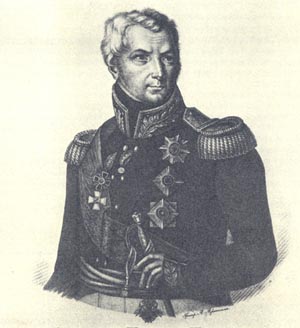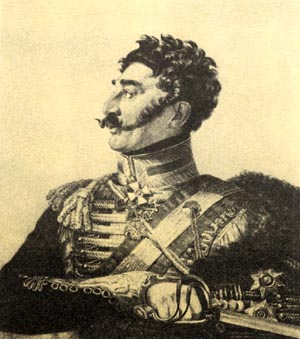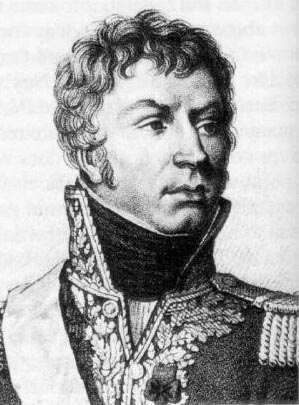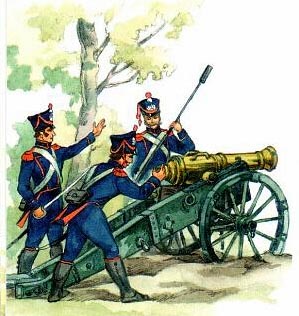July, 27 (15)
(From J.Lubchenkov "The War OF 1812 ", Moscow, 1998)
 General Tormasov
General Tormasov by Afanasiev |
On July, 13th (July,1) Barclay de Tolly told General Tormasov (the commander of the 3rd Russian Army) the orders of Emperor Alexander.
These were the words:" After collecting your army you have to move forward and attack firmly the flank of the enemy that acts against Prince Bagration. Bagrations is moving to Slutsk and Bobruysk, the French troops are moving to Pinsk".
This enemy was the Saxon Corps of General Renier. Tormasov already knew the French had occupied Brest, Kobrin, Yanovo and Pinsk. So the commander of the 3rd Army decided to first dislodge the French from these cities, and then take the enemy in the rear.
Tormasov formed three detachments. The first, under the command of General-Aide-de-Camp Count Lambert, was sent along the bank of the Bug river to Brest. The second, under Major-General Sherbatov, would join Lambert's detachment near Brest and capture the city. After this it would have to go to Kobrin where Tormasov led the main forces of his army. At the same time, the third detachment of Major-General Melissino went to Yanov across the Pina river. It was to make the enemy think the army of Tormasov was moving to Pinsk and nowhere else.
The Russian commander's plan was successful: General Renier had heard the loud movement of Melissino and, hurling all his Corps on Yanov and Tormasov on July,23rd (11), moved to Kobrin.
The Russians crossed the river and pounced upon the careless Austrians. Austrian commander Hablentz lost three squadrons. He was sure the whole Russian army went behind Melissino and referred to retreat to join the main forces.
 Lieutenant-Colonel Prince Madatov
Lieutenant-Colonel Prince Madatov by Dow |
At the same time, something similar was happening near the walls of Brest. General Sherbatov came to the city before Count Lambert. He had known only a detachment of the Saxonian cavalry defended the city and decided not to wait for Lambert. He attacked the city.
Only with cavalry, Sherbatov burst into the city at night, broke up the enemy hussars and uhlans, and captured about 40 men including the detachment commander. At noon Lambert entered the city, and their joint troops went immediately to Kobrin. On the morning of July,27th (15) the troops reached Kobrin. Tormasov came with the main forces of the 3rd Army.
The town of Kobrin was defended by the most powerful Saxon detachment under the command of General Klenchel. He sent a part of his cavalry and infantry to the Brest road, but it was too late: the Saxons saw the cavalry and horse artillery of Lambert only 2 versts far from the town. The commanders tried to make some sort of fortifications, but they were too late.
General Knenchel divided his troops again. He sent some squadrons of cavalry and infantry to the Dvina road, when he knew the Russians were coming to Kobrin along this road. It was General Tormasov. Was this what Napoleonic General hoped for? Nobody knew. After the careful inspection of the positions, Tormasov ordered General Lambert to begin the attack, Major-General Chaplits, to go to the right and attack the town from the Antopol road; Lieutenant-Colonel Prince Madatov - to cross the river Mukhavets and cut off the enemy path of retreat to Pruzhany.
The road was like all Russian roads that led to the town. The dust raised on it by the Saxons that rushed here to stop Lambert had not settled yet.
The soldiers of the Great Army urgently built crude earthen ramparts, breastworks and entrenchments across and along both sides of the road. And had placed guns to sweep off the impudent Russians by case-shot volleys. The faint tinkling of harness metal was heard - the cavalry waited.
At last Lambert appeared, leading his squadrons at a trot. The Saxon cannoneers pressed themselves to their guns, grinning. The infantry gripped their rifles and prepared to shoot. They all were waiting for the frontal attack of the Russian cavalry. This would be stopped by gun and rifle volleys, and afterwards, the cavalry of General Renier would deal the final blow to the scattered horsemen.
But suddenly the Russian cavalry began to leave the road: the forest was located in the distance, so the Calvary could move freely and attack the enemy from any direction. The massive tramp of horses began to move aside. The cloud of dust with strips of raised sabres shining through it went off to the left. The Saxons began turning their guns, cursing, but the Russian cavalrymen moved quickly, and after only a few minutes, stroke at the junction of General Renier's infantry and cavalry.
The Russian mass of cavalry appeared in front of the Saxon infantry as in a nightmare with the thunder of horses and metal tinkling. The Saxon artillery could fire only one volley - with very little success.
 General Renier
General Renier |
At this moment Major-General Chaplits rushed to the attack. As he was ordered, he dislodged the enemy squadrons from the Dvina road and began moving to the right, cutting off the Antopol road.
Klenchel's soldiers risked a try to go to Pruzhany and Antopol, but Chaplits and Prince Madatov were waiting for them there. Klenchel, like an octopus, pulled his detachments into the town to defend it.
The Russian commander sent several regiment with orders to assault the town from all sides simultaneously.
 French artillerymen in action
French artillerymen in action |
At the draw-bridge, Klenchel's soldiers resisted even more persistently. Their rifles and guns made attack impossible Several Russian attacks were repulsed by volleying fire. At last the volunteers came forward. Their first ranks were slaughtered at once and stained the bridge with their blood, but the ones that followed them didn't give the enemy time to reload their guns. The Russian soldiers rushed to the attack with arms raised. They swept the flimsy fortification and bayoneted all defenders - revenge for their fallen comrades. The last Saxon fortification had fallen and they hoisted a white flag.
This Russian victory caused great confusion in the French Headquarters. The Great Army troops had capitulated for the first time in the campaign. This was very good for the spirit of retreating Russian Army.